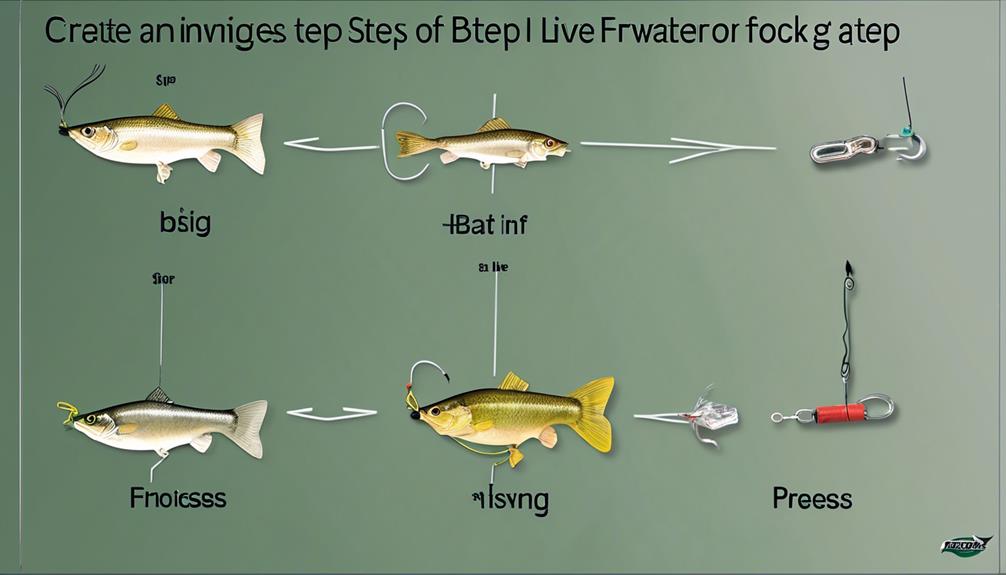You've just reeled in a beautiful catch, but did you know that studies show nearly 20% of released fish die within a few days due to improper handling and care? It's crucial to understand the essential tips for keeping caught freshwater fish alive, especially if you're practicing catch and release.
Whether you're an experienced angler or new to the sport, these 14 tips can make a significant difference in the survival rate of the fish you release back into the water.
So, how can you ensure that the fish you catch have the best chance at thriving once they're back in their natural habitat?
Proper Catch and Release Techniques
To ensure the survival of caught fish, it's crucial to employ proper catch and release techniques when engaging in freshwater fishing. When you catch a fish and plan to release it, you need to be aware of the stress it undergoes. Handling the fish properly can significantly reduce this stress, improving the chances of its survival after release. The stress experienced by the fish can have a direct impact on its health and ability to thrive once it's back in the water. By using the right techniques, you can minimize this stress and ensure the fish has the best possible chance of survival.
Improper catch and release practices can have a detrimental environmental impact. If the fish isn't handled correctly, it may suffer from injuries that can ultimately lead to death. Additionally, releasing a stressed and injured fish back into the water can disrupt the natural balance of the ecosystem. Injured fish may struggle to survive and can become easy prey for predators, impacting the overall population of fish in the area. By employing proper catch and release techniques, you can help maintain the ecological balance of the freshwater environment and contribute to the sustainability of fish populations.
Handling and Unhooking With Care
When handling and unhooking a fish, ensure a secure grip to minimize stress and potential injury. Proper handling techniques are crucial for the well-being of the fish post-release. When lifting the fish, support its weight with both hands, avoiding excessive pressure on the abdomen. This minimizes stress and reduces the risk of internal injury. Additionally, wet your hands before handling the fish to protect its delicate skin and scales. This simple step can help maintain the fish's protective mucus layer, which is essential for its health and survival.
When it comes to hook removal, it's important to work efficiently to minimize the fish's time out of the water. Use long-nose pliers or a de-hooking tool to carefully remove the hook, taking care not to cause further injury. If the fish is deeply hooked or the hook is difficult to remove, consider cutting the line close to the hook instead of attempting to dislodge it. This can be less traumatic for the fish and increase its chances of survival after release.
Minimizing Air Exposure
After ensuring a secure grip and carefully unhooking the fish, it's crucial to minimize air exposure to maintain its well-being during the release process. Fish are highly sensitive to air exposure, and prolonged exposure can lead to stress and even mortality. To minimize air exposure, consider using oxygenation methods such as keeping the fish submerged in a well-aerated livewell or placing an oxygenation stone in the transport container. This will help ensure that the fish receives an adequate supply of oxygen, reducing the risk of stress and improving its chances of survival upon release.
Moreover, water temperature plays a significant role in minimizing air exposure. When transporting fish, it's essential to maintain a suitable water temperature to reduce stress. Sudden temperature changes can shock the fish and increase its susceptibility to stress-related illnesses. Therefore, it's crucial to keep the water temperature consistent with the fish's natural habitat.
Additionally, minimizing air exposure during the release process can be achieved by swiftly returning the fish to the water. By reducing the time the fish spends out of the water, you can effectively lower the risk of stress and enhance its chances of a successful release.
Using a Fish-Friendly Net
Consider using a mesh net with rubberized netting to minimize harm to the fish's scales and fins during the landing process. When handling a fish-friendly net, it's crucial to minimize unnecessary stress on the fish. Proper net handling is essential for reducing fish stress and ensuring their safe release back into the water.
Start by approaching the fish gently and smoothly scooping it up with the net. Avoid making sudden movements that could startle or injure the fish. Once the fish is in the net, avoid lifting it too high above the water's surface to prevent unnecessary stress. Keep the net submerged to support the fish's weight and reduce the risk of injury.
When moving the fish to a holding container or unhooking it, handle the net with care. Avoid dragging the fish across the netting, which could damage its delicate scales and fins. Instead, gently guide the fish out of the net and into the container. If you need to unhook the fish while it's in the net, do so quickly and with minimal handling to reduce stress.
After releasing the fish, inspect the net for any hooks or tangles to ensure it's ready for the next catch. Proper net handling not only minimizes harm to the fish but also helps maintain the net's longevity. By using a fish-friendly net and handling it with care, you can contribute to the well-being of the fish population in your local waters.
Keeping Fish in a Livewell
To keep freshwater fish in a livewell, ensure proper aeration, water quality, and temperature control to maintain their health and vitality. Livewell maintenance is crucial for the well-being of the fish you catch.
Start by checking the oxygen levels in the livewell. One effective oxygenation technique is to install a quality aerator to ensure the fish have enough oxygen to breathe. This can be particularly important if you plan to keep the fish in the livewell for an extended period. Regularly inspect and clean the aerator to ensure it functions optimally.
Additionally, maintaining high water quality is essential for the health of the fish. To do this, regularly monitor and adjust the pH levels and ammonia concentration in the livewell. Use a water test kit to measure these parameters and make necessary adjustments to maintain a healthy environment for the fish. Remember to change the water in the livewell regularly to prevent the accumulation of waste and maintain optimal water conditions.
Temperature control is another critical aspect of livewell maintenance. Use a thermometer to monitor the water temperature and adjust it as needed to keep it within the suitable range for the specific species of fish you've caught. Sudden fluctuations in water temperature can stress the fish, so it's important to keep it stable.
Maintaining Water Quality
Monitoring and adjusting the pH levels and ammonia concentration in the livewell is crucial for maintaining high water quality and ensuring the health of the fish. Testing water regularly using a reliable kit will help you keep track of these parameters. The optimal pH level for freshwater fish is generally between 6.5 and 7.5. If the pH level is too high or too low, it can stress the fish and compromise their immune system, making them more susceptible to diseases. On the other hand, ammonia is extremely toxic to fish, even at low levels. Testing for ammonia and keeping it at zero is essential for the well-being of the fish.
In addition to monitoring pH and ammonia levels, it's important to ensure that the livewell has sufficient oxygen levels. Fish need oxygen to breathe, and the livewell water must be adequately oxygenated to keep them healthy. Aerate the water by adding an oxygenating system or periodically splashing water into the livewell to increase oxygen levels. Ensuring proper oxygenation will help reduce stress on the fish and improve their chances of survival once released back into the water.
Monitoring Fish Behavior

To assess the well-being of your caught freshwater fish, closely observe their behavior in the livewell for any signs of distress or abnormal activity. Observing fish behavior is crucial in ensuring their health and survival.
Look for signs of stress, such as erratic swimming patterns, gasping at the water's surface, or rubbing against the walls of the livewell. These behaviors can indicate that the fish are struggling to acclimate to their new environment or are experiencing discomfort. Additionally, keep an eye out for any changes in coloration, as pale or darkened patches may be a sign of distress.
Recognizing stress signals displayed by the fish is essential for taking prompt action to address any issues. If you notice any concerning behavior, consider adjusting the water temperature or adding a fish-friendly de-stressing agent to the livewell. It's also important to handle the fish gently and minimize any unnecessary disturbances to help reduce their stress levels.
Releasing Fish Safely
As you observe the behavior of your caught freshwater fish in the livewell, it's essential to prepare for their safe release back into their natural habitat. Before releasing the fish, ensure that they've fully recovered from the stress of being caught. To do this, gently support the fish in the water, allowing it to regain its strength and equilibrium.
It's crucial to practice ethical fishing practices during the release process, such as handling the fish with care and avoiding unnecessary harm.
When releasing the fish, consider the environmental impact of your actions. Choose release locations carefully, opting for areas with suitable habitat and water conditions. Avoid releasing fish into waters where they aren't native, as this can disrupt the local ecosystem. Additionally, refrain from releasing fish in areas where fishing is prohibited or where the fish could be easily caught again, causing unnecessary stress.
To minimize the environmental impact, release the fish gently, allowing it to swim away at its own pace. Avoid forcefully tossing the fish back into the water, as this could cause injury or disorientation.
Frequently Asked Questions
How Can I Transport Caught Freshwater Fish From the Fishing Spot to My Home Without Harming Them?
When transporting caught freshwater fish, ensure a good oxygen supply and maintain water temperature. Minimize stress by handling gently. Aerate the water and use a portable fish tank or bucket for transportation to keep them alive and healthy.
What Should I Do if I Accidentally Hook a Fish in a Sensitive Area, Such as the Gills or Eyes?
If you accidentally hook a fish in a sensitive area, such as the gills or eyes, handle the injuries carefully. Proper treatment is crucial for catch and release and to maintain ethical fishing practices.
Are There Any Specific Types of Bait or Lures That Are Less Harmful to Fish When Catch and Release Fishing?
When catch and release fishing, consider using eco-friendly bait options and sustainable fishing practices. These can help reduce harm to fish. Look for biodegradable options and barbless hooks to minimize impact.
How Can I Prevent My Livewell From Becoming Overcrowded and Causing Stress to the Fish?
To prevent your livewell from becoming overcrowded and causing stress to the fish, manage the livewell properly. Use appropriate transportation and fish handling techniques to ensure the fish remain healthy and stress-free.
Is There a Recommended Temperature Range for the Water in the Livewell to Keep the Caught Fish Healthy and Alive?
To keep your caught fish healthy and alive, it's crucial to maintain the livewell temperature within the recommended range. Regularly check and adjust the temperature, and ensure proper livewell aeration to create a conducive environment for the fish.
Conclusion
So remember, when catching freshwater fish, it's important to handle them with care and release them safely back into the water.
By following these essential tips, you can help ensure the survival of the fish population and maintain a healthy ecosystem.
Happy fishing!



